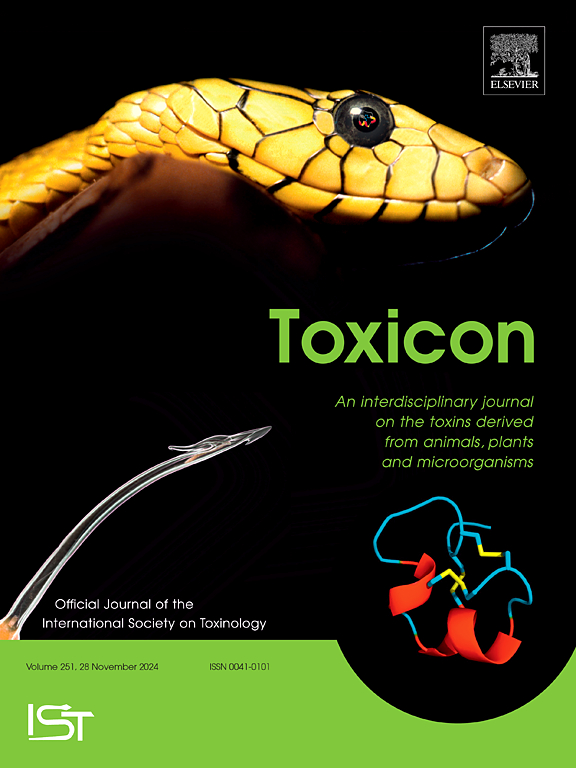Geographic variation in stonefish (Synanceia spp.) venom
IF 2.6
4区 医学
Q2 PHARMACOLOGY & PHARMACY
引用次数: 0
Abstract
Stonefish (Synanceia spp.) possess a medically significant venom and are widely distributed throughout the Indo-Pacific. Yet, little is known about how the ecology of these animals may influence their venom. The aim of this study was to explore the effect of species and geographic location on stonefish venom composition. We collected the venom of Synanceia horrida (Estuarine Stonefish) and Synanceia verrucosa (Reef Stonefish) from various locations across Australia (Cairns, Brisbane, Caloundra, and Onslow), and Southeast Asia (Kota Kinabalu, and Cebu) and analysed these samples using SDS-PAGE, FPLC, and HPLC. Stonefish have a complex venom comprised of numerous components. Stonefish venom exhibited both similarities and variations in composition within species between geographically isolated populations, as well as between species in a single location. We speculate that the observed geographic and interspecific trends may be driven by similarities and differences in the selective pressures faced by these animals, particularly those associated with predator dynamics. The findings of this study have furthered our understanding of the ecology of stonefish and their toxins.

石鱼毒液的地理变异。
石鱼(Synanceia spp.)广泛分布在印度-太平洋地区,然而,地理位置对其毒液成分的影响目前尚不清楚。本研究的目的是确定地理位置对石鱼毒液组成的影响,包括种间和种内。为了量化这一点,我们从澳大利亚(凯恩斯、布里斯班、卡隆德拉和昂斯洛)和东南亚(哥打基那巴鲁和宿务)的不同地点收集了恐怖和疣状synancia的毒液样本。使用SDS-PAGE、FPLC和HPLC等多种分析技术对这些样品进行分析。这项研究的结果强调,石鱼有一个复杂的毒液档案由许多成分组成。石鱼毒液成分的组成表现出种间和种内的相似性和不同地点之间的差异。我们推测,观察到的地理趋势可能是由选择压力的相似性和差异性驱动的,特别是与捕食者动态有关。这项研究的发现进一步加深了我们对石鱼生态及其毒素的了解。
本文章由计算机程序翻译,如有差异,请以英文原文为准。
求助全文
约1分钟内获得全文
求助全文
来源期刊

Toxicon
医学-毒理学
CiteScore
4.80
自引率
10.70%
发文量
358
审稿时长
68 days
期刊介绍:
Toxicon has an open access mirror Toxicon: X, sharing the same aims and scope, editorial team, submission system and rigorous peer review. An introductory offer Toxicon: X - full waiver of the Open Access fee.
Toxicon''s "aims and scope" are to publish:
-articles containing the results of original research on problems related to toxins derived from animals, plants and microorganisms
-papers on novel findings related to the chemical, pharmacological, toxicological, and immunological properties of natural toxins
-molecular biological studies of toxins and other genes from poisonous and venomous organisms that advance understanding of the role or function of toxins
-clinical observations on poisoning and envenoming where a new therapeutic principle has been proposed or a decidedly superior clinical result has been obtained.
-material on the use of toxins as tools in studying biological processes and material on subjects related to venom and antivenom problems.
-articles on the translational application of toxins, for example as drugs and insecticides
-epidemiological studies on envenoming or poisoning, so long as they highlight a previously unrecognised medical problem or provide insight into the prevention or medical treatment of envenoming or poisoning. Retrospective surveys of hospital records, especially those lacking species identification, will not be considered for publication. Properly designed prospective community-based surveys are strongly encouraged.
-articles describing well-known activities of venoms, such as antibacterial, anticancer, and analgesic activities of arachnid venoms, without any attempt to define the mechanism of action or purify the active component, will not be considered for publication in Toxicon.
-review articles on problems related to toxinology.
To encourage the exchange of ideas, sections of the journal may be devoted to Short Communications, Letters to the Editor and activities of the affiliated societies.
 求助内容:
求助内容: 应助结果提醒方式:
应助结果提醒方式:


